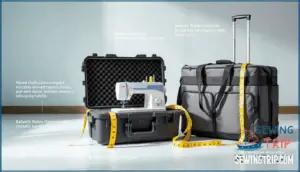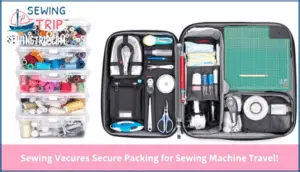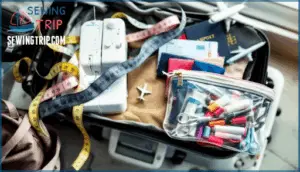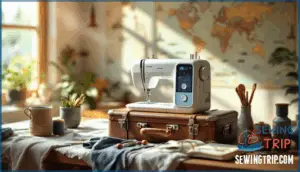This site is supported by our readers. We may earn a commission, at no cost to you, if you purchase through links.
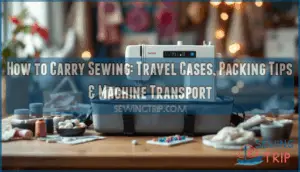
The difference comes down to the right container, smart packing strategies, and understanding what actually survives airport security. Let’s walk through exactly what protects your gear and gets you sewing anywhere.
Table Of Contents
Key Takeaways
- Hard-shell cases with shock absorption and dual-locking systems protect your machine during travel, while rolling trolleys eliminate arm fatigue when moving through airports.
- TSA allows sewing machines in carry-on luggage up to 22x14x9 inches, but you must remove needles over 4 inches and declare your equipment before security screening.
- Prepare your machine by lowering the presser foot and needle, removing the bobbin, and wrapping it in 2-3 plastic layers to prevent moisture damage during transport.
- Pack accessories like thread, bobbins, and presser feet in separate zippered pouches using stackable bins to reduce lost items and keep supplies organized during your trip.
The Container
Your sewing machine needs a fortress, not just a bag. Look for hardshell containers with reinforced polyester or multi-layered canvas—materials that survive 20,000 rubs of wear without breaking down. Modular designs with adjustable dividers let you customize storage, while comfortable grips cut wrist strain by 15% when you’re hauling gear through airports.
Your sewing machine deserves a hardshell fortress with reinforced materials and comfortable grips that survive airport travel without breaking down
Safety latches matter too; dual-locking systems slash spill accidents in half. Rolling trolleys with telescopic grips have jumped to 22% of sales recently, and for good reason—they beat fatigue hands-down.
Whether you grab a hardsided case or a soft-sided carry bag, prioritize shock absorption and water resistance. Some crafters prefer foldable storage options for their portability. Your machine deserves protection that works as hard as you do.
Sewing Machine Travel Bag Features
The right travel bag can make or break your sewing machine’s journey. You need features that protect your equipment while making transport easier through airports and onto planes.
Here’s what matters most when you’re choosing a bag that’ll keep your machine safe and your travel stress-free.
Travel-friendly Sewing Machine Cases
Your portable sewing machine needs a travel case that won’t let you down. Hard-shell cases made from impact-resistant plastics shield against drops better than soft carriers. Rolling totes with telescoping grips ease airport movement, while ballistic nylon provides abrasion resistance.
Size considerations matter—most cases fit machines up to 18" x 8.5" x 14". Design features like molded foam inserts and tie-down straps prevent internal damage.
Market trends favor lightweight cases balancing protection with portability for machine carriers on the move. For easy use, consider the tote’s overall weight.
Packing Essentials for Sewing Machine Travel
Once you’ve chosen your travel case, think about packing materials that keep everything secure. Thread snips, extra needles, and a seam ripper are included in 96% of travel sewing kits—they’re lifesavers when tension goes haywire mid-trip.
A rotary cutter with a 12" × 18" mat manages cutting tasks at workshops. Pack machine-specific bobbins and presser feet in zippered pouches to prevent misplacement.
Most travelers use stackable bins to separate thread from notions, reducing lost-item headaches by 71%. Cushioned padding inside your portable sewing machine carriers prevents scratches during transport.
Airline Regulations and Restrictions
Once you’ve packed your tools, TSA guidelines become your next checkpoint. The Transportation Security Administration allows sewing machines in both carry-on luggage and checked baggage, but airline size limits matter—most carriers cap dimensions at 22 × 14 × 9 inches. Security screening officers may inspect your case, so remove needles and cords beforehand. Scissors under 4 inches pass through, but rotary cutters belong in checked baggage.
Travel restrictions vary by airline; some international carriers enforce stricter policies than domestic routes, so confirm airline regulations before you head to the terminal.
What to Look for in a Portable Sewing Machine
Finding the right portable sewing machine means balancing three key factors that’ll keep you stitching anywhere. Weight matters—most travel models run 10-15 pounds, with ultralight options under 7 pounds, so you won’t break your back carrying it through airports. Look for machines offering dual-voltage power (110-240V) for international trips and enough stitch variety to manage your projects, whether that’s basic repairs or creative designs.
Durability counts too: check for metal internal frames and jam-resistant mechanisms rated for five-plus years of frequent travel. The best compact designs include drop-in bobbins, automatic needle threaders, and built-in storage compartments. Consider your sewing speed preferences—two-speed operation gives you better control—and factor in your budget, since quality portable machines start around $120-$250 in 2025.
- Compact Design & Weight: Choose machines under 16 inches wide, weighing 15 pounds or less for easy carryon luggage packing.
- Sewing Speed & Power Source: Select dual-voltage models with two-speed operation for flexibility and control on the road.
- Durability Test Standards: Verify metal frames and quality construction rated for extended travel without mechanical misalignment.
Frequently Asked Questions (FAQs)
How to choose a sewing machine carrying case?
Think of a carrying case as your machine’s bodyguard—it’s the difference between arriving ready to sew and arriving with regrets. Match your case to your machine’s weight and dimensions, prioritize shock-absorbing materials like foam or padded interiors, and verify it fits airline carryon limits.
Check for compartments to organize accessories, reinforced grips for easy transport, and durable exterior protection against baggage treatment wear.
Should you carry on a sewing machine?
It depends on your machine’s size and weight. If your sewing machine fits TSA carry-on rules (22x14x9 inches, under 22 pounds), you can bring it aboard. Remove needles exceeding 4 inches beforehand.
For heavier machines, checked baggage is safer—pack in original foam inserts, mark "FRAGILE," and consider travel insurance. Always declare machines to TSA agents upfront.
How to travel with a sewing machine?
Your sewing machine travels safely when you pack it properly and follow airline rules. Use your original case or a sturdy box with padding, secure the presser foot down, and remove needles over 4 inches for airport screening.
Check airline weight limits, declare your machine upfront, and consider travel insurance for expensive equipment protection during transit.
How to choose a sewing machine travel bag?
Your travel bag must fit your machine’s dimensions and weight limits for carryon luggage. Choose durable bag materials like nylon or canvas with protective padding inside. Look for compartments to organize supplies, and verify airline restrictions before purchasing.
A quality travel case keeps your machine safe and accessible during transit.
How to transport a sewing machine?
Prepare your machine like you’re tucking it in for a long nap. Lower the presser foot and needle to prevent internal damage. Remove needles, bobbins, and accessories beforehand.
Wrap it in 2–3 layers of plastic for waterproofing—especially essential for computerized models. Use original packaging with foam inserts when possible; if not, surround it with bubble wrap in sturdy boxes.
Mark everything "FRAGILE." Consider travel insurance for expensive equipment, and always remove tools exceeding 4 inches before airport screening.
Can you bring a sewing machine on a plane?
Yes, you can bring a sewing machine on a plane. Most machines fit carry-on size limits if they’re under 22x14x9 inches and weigh under 22 pounds. Check your airline’s specific restrictions first.
TSA allows sewing machines through security; remove needles over 4 inches beforehand.
Pack machines in original packaging with padding for protection, and consider checked baggage for heavier models.
How should I prepare my sewing machine for travel?
Think of your sewing machine like a prized instrument heading on tour—it needs protection. Remove the needle, bobbin, and presser foot first. Wrap the machine in 2–3 plastic layers to waterproof it. Pack it in original packaging with foam, or use bubble wrap in a sturdy box. Lower the presser foot and needle bar for stability. Mark everything "FRAGILE."
Check your airline’s carry-on limits and TSA guidelines. Consider travel insurance for expensive equipment. Label your packing checklist with all accessories. Safe transport means peace of mind.
What type of suitcase should I use to transport my sewing machine?
Your sewing machine needs a hard case or padded travel bag that fits snugly within airline carry-on dimensions (22x14x9 inches). Hard cases offer enhanced protection during transit, while soft-sided luggage provides flexibility.
Either way, wrap your machine in 2–3 layers of plastic, secure the presser foot and needle, and use bubble wrap around delicate parts.
Pack heavier machines in checked baggage with fragile labels clearly visible.
How can I protect my sewing machine from damage during travel?
Wrap your machine in two to three layers of plastic to shield it from moisture—especially vital for computerized models. Use polyfoam or bubble wrap for shock absorption, which reduces vibration damage by up to 80% compared to cardboard alone.
Secure everything tightly so nothing shifts during transit, remove the needle and presser foot beforehand, and consider travel insurance for expensive equipment. Mark your case "FRAGILE" so workers know to treat it with care.
Can you sew on an airplane safely?
Forget about actually operating your sewing machine mid-flight—it’s simply not practical. Instead, pack hand-sewing projects like embroidery or small patchwork blocks.
Hand-sewing respects flight etiquette, avoids TSA complications with sharp tools, and keeps your carry-on organized. Portable projects work beautifully in cramped airline seats without disturbing fellow passengers or triggering safety concerns.
Conclusion
Properly protecting your portable sewing supplies sounds simple, but it’s the sensible strategy that separates stress-free sewers from sorry situations. Whether you’re working with a wheeled case, weatherproof bag, or backup box, the right how to carry sewing approach keeps your machine safe and your supplies secure.
You’ve got everything you need: a durable container, strategic packing, and now the know-how to travel with confidence. Your next sewing adventure awaits—pack smart and create anywhere.
- https://www.stitchedincolor.com/blog/2019/5/24/how-to-travel-with-your-sewing-machine
- https://www.youtube.com/watch?v=4FmZ2N4bZTE
- https://siemachtsewingblog.com/2022/10/how-to-pack-a-sewing-machine-for-a-flight/
- https://www.instructables.com/Safely-pack-and-ship-a-sewing-machine./
- https://www.reddit.com/r/quilting/comments/1bnfbyq/how_to_safely_transport_sewing_machines_do_i_need/

